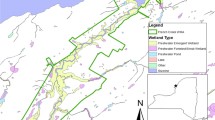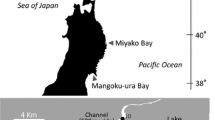Abstract
Changes in spawning habitat of northern pike (Esox lucius) may affect their segregation from and coexistence with the closely related muskellunge (E. masquinongy). We estimated the areal coverage of robust and shallow emergent vegetation in three shared-spawning bays in the Upper St. Lawrence River from aerial photographs taken from 1948 to 2003. Robust emergent vegetation (e.g., cattail) increased in coverage by 155–241% while shallow emergents (sedges) decreased by 46–96%. The loss of sedges, an important northern pike-spawning habitat, may facilitate greater spawning overlap in offshore-submersed aquatic vegetation within bay habitats used by muskellunge. Development rates and characteristics of northern pike and muskellunge eggs and larvae were compared to better understand the implications of greater spawning overlap. Northern pike eggs developed faster than muskellunge eggs at temperatures of 4.7–19°C, and adhesive eggs and the presence of adhesive papillae were present in both species. Equations were used to predict degree-day requirements for hatching and swim-up in three habitats (shallow emergents, bay, and offshore shoal) along a temperature gradient. Northern pike required more estimated degree days to reach hatching in bay and offshore shoal habitat relative to shallow emergent habitat due to cooler temperatures. Significant spawning overlap is known to occur within bay habitats, but poor success of northern pike in deep bay habitats and overall reductions in abundance are hypothesized to currently buffer muskellunge from potential negative interactions between these species.






Similar content being viewed by others
References
Beland, M., 2003. Holocene vegetation dynamics of an Upper St. Lawrence River coastal wetland and surrounding uplands: effects of climate change and anthropogenic disturbance. Master’s Thesis, SUNY College of Environmental Science and Forestry, Syracuse, NY.
Bosworth, A. & J. M. Farrell, 2006. Genetic divergence among northern pike from spawning locations in the Upper St. Lawrence River. North American Journal of Fisheries Management 26: 676–684.
Bry, C., 1996. Role of vegetation in the life cycle of northern pike. In Craig, J. F. (ed.), Northern Pike: Biology and Exploitation. Chapman and Hall, Fish and Fisheries Series 19, London: 45–67.
Buss, K. & A. Larsen, 1961. The northern pike of Presque Isle Bay, Lake Erie. Pennsylvania Angler 30: 4–6.
Casselman, J. M. & C. A. Lewis, 1996. Habitat requirements of northern pike (Esox lucius). Canadian Journal of Fisheries and Aquatic Sciences 53(Suppl. 1): 161–174.
Colesante, R. T., 1977. Behavior of muskellunge fry during yolk absorption and swim-up. New York Fish and Game Journal 24: 94.
Cooper, E. L., 1983. Fishes of Pennsylvania and the Northeastern United States. Pennsylvania State University Press, University Park, Pennsylvania.
Cooper, J. E., 2000. Comparative development and ecology of northern pike Esox lucius and muskellunge E. masquinongy eggs and larvae in the Upper St. Lawrence River and the implications of changes in historical spawning habitat. PhD thesis, State University of New York, College of Environmental Science and Forestry, Syracuse, New York.
Crossman, E. J., 1978. Taxonomy and distribution of North American esocids. American Fisheries Society Special Publication 11: 13–26.
Dombeck, M. P., B. W. Menzel & P. N. Hinz, 1984. Muskellunge spawning habitat and reproductive success. Transactions of the American Fisheries Society 113: 205–216.
Dombeck, M. P., B. W. Menzel & P. N. Hinz, 1986. Natural muskellunge reproduction in midwestern lakes. American Fisheries Society Special Publication 15: 122–134.
Farrell, J. M., 1991. Spawning ecology of sympatric northern pike and muskellunge in the St. Lawrence River. Master’s thesis, State University of New York, College of Environmental Science and Forestry, Syracuse, New York.
Farrell, J. M., 1998. Population ecology of sympatric age-0 northern pike and muskellunge in the St. Lawrence River. PhD thesis, State University of New York, College of Environmental Science and Forestry, Syracuse, New York.
Farrell, J. M., 2001. Reproductive success of sympatric northern pike and muskellunge in an Upper St. Lawrence River bay. Transactions of the American Fisheries Society 130: 796–808.
Farrell, J. M. & R. G. Werner, 1999. Abundance, distribution, and survival of age-0 muskellunge in Upper St. Lawrence River nursery embayments. North American Journal of Fisheries Management 19: 310–321.
Farrell, J. M., R. G. Werner, S. R. LaPan & K. A. Claypoole, 1996. Egg distribution and spawning habitat of northern pike and muskellunge in a St. Lawrence River marsh, New York. Transactions of the American Fisheries Society 125: 127–131.
Farrell, J. M., J. V. Mead & B. A. Murry, 2006. Protracted spawning of St. Lawrence River northern pike (Esox lucius): simulated effects on survival, growth, and production. Ecology of Freshwater Fish 15: 169–179.
Farrell, J. M., R. M. Klindt, J. M. Casselman, S. R. LaPan, R. G. Werner & A. Schiavone, 2007. Development, implementation, and evaluation of an international muskellunge management strategy for the Upper St. Lawrence River. Environmental Biology of Fishes 79: 111–123.
Franklin, D. R. & L. L. Smith, 1963. Early life history of the northern pike, Esox lucius L., with special reference to strength of year classes. Transactions of the American Fisheries Society 92(2): 91–110.
Galat, D. L., 1973. Normal embryonic development of the muskellunge (Esox masquinongy). Transactions of the American Fisheries Society 102: 384–391.
Geis, J. W. & J. L. Kee, 1977. Coastal Wetlands along Lake Ontario and the St. Lawrence River in Jefferson County, New York. State University of New York, College of Environmental Science and Forestry, Syracuse, New York.
Hassan, K. C. & J. R. Spotila, 1975. The effect of acclimation on the temperature tolerance of young muskellunge fry. In Esch, G. W. & R. W. McFarlane (eds), Thermal Ecology II. Proceedings of a Symposium Held at Augusta, Georgia, April 2–5, 1975. Energy Research and Development Administration, Oak Ridge, Tennessee: 136–140.
Harrison, E. J. & W. F. Hadley, 1978. Ecologic separation of sympatric muskellunge and northern pike. American Fisheries Society Special Publication 11: 129–134.
Hokanson, K. E. F., J. H. McCormick & B. R. Jones, 1973. Temperature requirements for embryos and larvae of the northern pike, Esox lucius (Linnaeaus). Transactions of the American Fisheries Society 102: 89–100.
Hudon, C., 1997. Impact of water level fluctuations on St. Lawrence River aquatic vegetation. Canadian Journal of Fisheries and Aquatic Sciences 54: 2853–2865.
Inskip, P. D., 1986. Negative associations between abundances of muskellunge and northern pike: evidence and possible explanations. American Fisheries Society Special Publication 15: 135–150.
Keddy, P. A. & A. A. Reznicek, 1986. Great Lakes vegetation dynamics: the role of fluctuating water levels and buried seeds. Journal of Great Lakes Research 12: 25–36.
Klingbeil, J., 1986. Culture of purebred muskellunge. American Fisheries Society Special Publication 15: 273–278.
LaPan, S. R., 1985. Spawning and early life history of muskellunge and northern pike in the St. Lawrence River. Master’s thesis, State University of New York, College of Environmental Science and Forestry, Syracuse, New York.
Leslie, J. K. & J. F. Gorrie, 1985. Distinguishing features for separating protolarvae of three species of esocids. In Kendall, A. W. Jr. & J. B. Marliave (eds), Descriptions of Early Life History Stages of Selected Fishes: Third International Symposium on the Early Life History of Fishes, Canadian Technical Report of Fisheries and Aquatic Sciences, Number 1359: 1–20.
McCarraher, D. B. & R. E. Thomas, 1972. Ecological significance of vegetation to northern pike, Esox lucius, spawning. Transactions American Fisheries Society 101: 560–563.
McCullough, R. D. & J. J. Hart, 2005. Thousand Islands warmwater fish stock assessment. New York State Department of Environmental Conservation. Lake Ontario Annual Report 2005 (St. Lawrence River), Section 6: 1–14.
Monfette, R., S. Guenette, N. Dubuc, R. Fortin & H. Fournier, 1996. Northern pike and muskellunge spawning ecology and reproductive success in the lower Ottawa River. In Kerr, S. J. & C. H. Olver (eds), Managing Muskies in the 90s. Workshop Proceedings. Ontario Ministry of Natural Resources, Southern Region Science and Technology Transfer Unit WP-007, 55–66.
Murry, B. A. & J. M. Farrell, 2007. Quantification of native muskellunge nursery: influence of body size, fish community composition, and vegetation structure. Environmental Biology of Fishes 79: 37–47.
Osterberg, D. M., 1985. Habitat partitioning by muskellunge and northern pike in the International portion of the St. Lawrence River. New York Fish and Game Journal 32: 158–166.
SAS Institute Inc., 2002. Version 8. Cary, North Carolina.
Smith, B. M., 2000. Year-class formation of St. Lawrence River northern pike. Master’s thesis, State University of New York, College of Environmental Science and Forestry, Syracuse, New York.
Smith, B. M., J. M. Farrell, H. B. Underwood & S. J. Smith, 2007. Year class formation of Upper St. Lawrence River northern pike. North American Journal of Fisheries Management 27: 481–491.
Strand, R. F., 1986. Identification of principal spawning areas and seasonal distributions and movements of muskellunge in Leech Lake, Minnesota. American Fisheries Society Special Publication 15: 62–73.
Sorenson, L., K. Buss & A. D. Bradford, 1966. The artificial propagation of esocid fishes in Pennsylvania. Progressive Fish-Culturist 28: 133–141.
Swift, D. R., 1965. Effect of temperature on mortality and rate of development of the eggs of the northern pike (Esox lucius L.) and the perch (Perca fluviatilis L.). Nature 206: 528.
US Fish and Fisheries Commission, 1897. Methods of the United States Commission of fish and fisheries with chapters on the cultivation of oysters and frogs. US Fish Commission Report for 1897. US Fish and Fisheries Commission, Washington, DC.
Williamson, L. O., 1942. Spawning habits of muskellunge and northern pike. Wisconsin Conservation Bulletin 7: 10–11.
Wilcox, D. A. & J. E. Meeker, 1992. Implications for faunal habitat related to altered macrophyte structure in regulated lakes in northern Minnesota. Wetlands 12(3): 192–203.
Zorn, S. A., T. L. Margenau, J. S. Diana & C. J. Edwards, 1998. The influence of spawning habitat on natural reproduction of muskellunge in Wisconsin. Transactions of the American Fisheries Society 127: 995–1005.
Acknowledgments
This research was partially funded by the New York State Department of Environmental Conservation (Federal Aid in Sport Fish Restoration grant FA-5-R), Wildlife Forever, Inc., and the Wilford A. Dence Memorial Fellowship (to JEC). We also thank Richard T. Colesante, Rodger Klindt, and Steven LaPan of NYSDEC, and Brian Smith, Ducks Unlimited. Kim Farrell provided a critical review of the work. This research is a contribution of the Thousand Islands Biological Station.
Author information
Authors and Affiliations
Corresponding author
Additional information
Guest editors: J. M. Farrell, C. Skov, M. Mingelbier, T. Margenau & J. E. Cooper
International Pike Symposium: Merging Knowledge of Ecology, Biology, and Management for a Circumpolar Species
Rights and permissions
About this article
Cite this article
Cooper, J.E., Mead, J.V., Farrell, J.M. et al. Potential effects of spawning habitat changes on the segregation of northern pike (Esox lucius) and muskellunge (E. masquinongy) in the Upper St. Lawrence River. Hydrobiologia 601, 41–53 (2008). https://doi.org/10.1007/s10750-007-9265-0
Published:
Issue Date:
DOI: https://doi.org/10.1007/s10750-007-9265-0




